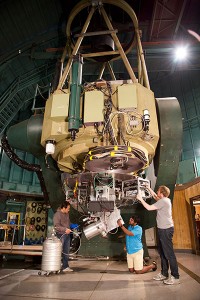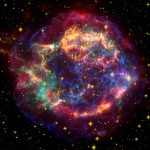
In May 2017, Prof. Dae-Sik Moon, Prof. Suresh Sivanandam and PhD student Elliot Meyer installing WIFIS on the 2.3-metre Bok Telescope at the Steward Observatory in Arizona. Image: Prof. Suresh Sivanandam; Dunlap Institute
“First Light” for WIFIS, the Wide Integral-Field Infrared Spectrograph
[Toronto] An innovative astronomical spectrograph has achieved “first light”, the start of its life as a scientific tool for studying objects such as colliding galaxies, stellar nurseries and the remnants of exploded stars.Spectrographs are instruments which spread out light according to wavelength, just as a prism spreads out a beam of sunlight into a “rainbow” of its constituent colours. The spectra created by the spectrograph reveals detailed information about the light source’s composition, motion, age, and more.
In May, 2017, after years of development, fabrication and testing, a team of astronomers from the University of Toronto installed the Wide Integral-Field Infrared Spectrograph (WIFIS) on the 2.3-metre Bok Telescope at the Steward Observatory in Arizona.
“WIFIS has the largest field-of-view of any infrared spectrograph of its type,” says WIFIS Principal Investigator, Prof. Dae-Sik Moon, from the Department of Astronomy & Astrophysics, University of Toronto. “This makes WIFIS a unique instrument ideally suited for observing large objects.”
With the wide viewing field of WIFIS, astronomers can capture, in a single observation, the light of astronomical objects that appear larger in our sky than stars or very distant galaxies; targeting the same objects, spectrographs with narrower fields-of-view would require many more observations.
“With WIFIS,” says Moon, “we will study supernova explosions by observing young supernova remnants, the motion of gases in star-forming regions, massive stellar clusters, populations of stars within galaxies, merging galaxies, the formation of massive stars in galaxies, and much more.”

Cassiopeia A is a remnant of a supernova and is typical of the types of objects WIFIS will target. It has already been observed with the new spectrograph. Image: NASA/JPL-Caltech
Prof. Suresh Sivanandam is a WIFIS co-investigator from the Dunlap Institute for Astronomy & Astrophysics, U of T. “WIFIS is important,” says Sivanandam, “because it helps fulfill the Dunlap’s mandate to deliver innovative, impactful instrumentation.”
“WIFIS represents the first major infrared instrument that was predominantly developed and constructed at the University of Toronto,” says Sivanadam. “Plus, training students is another part of our mandate, and WIFIS delivered there, too. It offered rich opportunities for students to learn the art of instrumentation development.”
At the University of Toronto, the WIFIS team also includes Dr. Richard Chou, and U of T astronomy PhD student Elliot Meyer. Previously, the team also included graduate students Max Millar-Blanchaer, Mark Ma, Miranda Jarvis and Bryn Orth-Lashley.
The international collaboration that developed WIFIS includes the University of Arizona, Korean Astronomy and Space Science Institute and the University of Florida.
-30-
Contact:
Prof. Dae-Sik Moon
Department of Astronomy & Astrophysics
University of Toronto
p: 416-978-6566
e: moon@astro.utoronto.ca
w: http://www.astro.utoronto.ca/~moon/
Prof. Suresh Sivanandam
Dunlap Institute for Astronomy & Astrophysics
University of Toronto
p: 416-978-6550
e: sivanandam@dunlap.utoronto.ca
w: http://www.dunlap.utoronto.ca/dunlap-people/prof-suresh-sivanandam/
Chris Sasaki
Communications Coordinator | Press Officer
Dunlap Institute for Astronomy & Astrophysics
University of Toronto
p: 416-978-6613
e: csasaki@dunlap.utoronto.ca
w: dunlap.utoronto.ca
The Dunlap Institute for Astronomy & Astrophysics at the University of Toronto is an endowed research institute with over 70 faculty, postdocs, students and staff, dedicated to innovative technology, ground-breaking research, world-class training, and public engagement. The research themes of its faculty and Dunlap Fellows span the Universe and include: optical, infrared and radio instrumentation; Dark Energy; large-scale structure; the Cosmic Microwave Background; the interstellar medium; galaxy evolution; cosmic magnetism; and time-domain science.
The Dunlap Institute, Department of Astronomy & Astrophysics, Canadian Institute for Theoretical Astrophysics, and Centre for Planetary Sciences comprise the leading centre for astronomical research in Canada, at the leading research university in the country, the University of Toronto.
The Dunlap Institute is committed to making its science, training and public outreach activities productive and enjoyable for everyone, regardless of gender, sexual orientation, disability, physical appearance, body size, race, nationality or religion.
###
